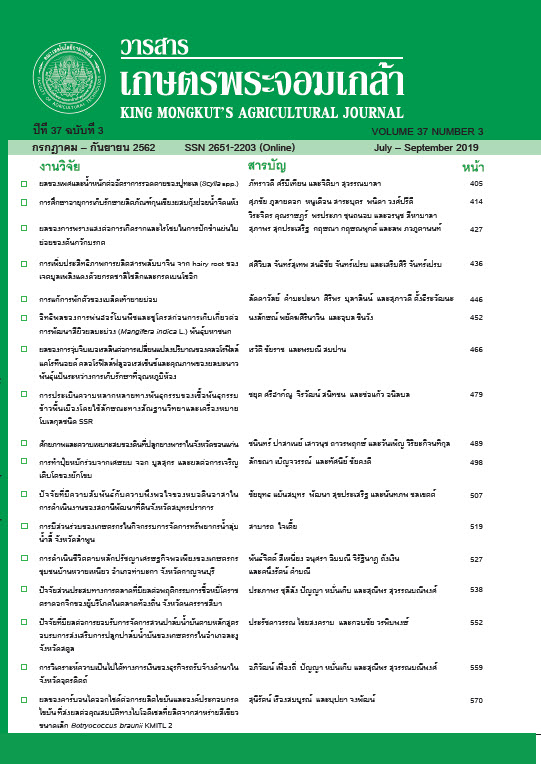การเพิ่มประสิทธิภาพการผลิตสารพลัมบาจิน จาก hairy root ของเจตมูลเพลิงแดง ด้วยกรดซาลิไซลิกและกรดเบนโซอิก
Main Article Content
บทคัดย่อ
เจตมูลเพลิงแดงเป็นพืชสมุนไพร ซึ่งมีรากเป็นแหล่งสะสมของสารพลัมบาจิน (plumbagin) สารนี้มีฤทธิ์
ยับยั้งการเจริญเติบโตของเซลล์มะเร็ง เชื้อแบคทีเรียและเชื้อราหลายชนิด การเพาะเลี้ยง hairy root เจตมูลเพลิงแดง
นี้จึงมีจุดมุ่งหมายเพื่อเพิ่มศักยภาพการผลิตสารพลัมบาจินจาก hairy root เจตมูลเพลิงแดง ด้วยการใช้สิ่งกระตุ้น โดย
เติมกรดซาลิไซลิก (salicylic acid) และกรดเบนโซอิก (benzoic acid) ให้มีความเข้มข้นสุดท้าย 10-40 มิลลิโมลาร์
ลงในอาหารเหลว ½ Murashige and Skoog (MS) ที่เพาะเลี้ยง hairy root อายุ 15 วัน ผลการศึกษา พบว่า
กรดซาลิไซลิกความเข้มข้นสุดท้าย 20 มิลลิโมลาร์ มีประสิทธิภาพในการกระตุ้นการผลิตสารพลัมบาจินจาก hairy root
และการปลดปล่อยสารพลัมบาจินออกสู่อาหารเพาะเลี้ยงมากที่สุด หลังการกระตุ้น 1 วัน (93.64 มิลลิกรัม
ต่อลิตร; 4.4 เท่าของชุดควบคุม) ส่วนกรดเบนโซอิกสามารถกระตุ้นการผลิตสารพลัมบาจินได้เล็กน้อยและไม่พบ
การปล่อยสารพลัมบาจินออกสู่อาหารเพาะเลี้ยง โดยพบสารพลัมบาจินสูงสุดเพียง 41.78 มิลลิกรัมต่อลิตร
(1.4 เท่าของชุดควบคุม) ในวันที่ 7 ของการกระตุ้น
Article Details
วารสารเกษตรพระจอมเกล้า
เอกสารอ้างอิง
Buitelaar, R. and J. Tramper. 1992. Strategies to improve the production of secondary metabolites with plant cell culture.
J. Biotech. 23: 111-141.
Chong, J., M.A. Pierrel, R. Atanassova, D.W. Reichhart, B. Fritig and P. Saindrenan. 2001. Free and conjugated benzoic
acid in tobacco plants and cell cultures: induced accumulation upon elicitation of defense responses and role as
salicylic acid precursors. Plant Physiol. 125: 318-328.
Chung, I.M., M. Thiruvengadam, K. Rekha and G. Rajakumar. 2016. Elicitation enhanced the production of phenolic
compounds and biological activities in hairy root cultures of bitter melon (Momordica charantia L.). Braz. Arch.
Biol. Technol. 59: e160393.
Chuntaratin, P. 2006. Production of Plumbagin by Hairy Root, Callus and Cell Suspension Cultures of Plumbago indica
L. Ph.D. Thesis. Kasetsart University, Thailand. 133p.
Ding, J., S. Shi, B.H. Jiang, Y.H. Yang, J. Huang, H.G. Shen, K. Xia and J. Jiang. 2004. Effect of methyl jasmonate with
indol-3-acetic acid and 6-benzylaminopurine on the secondary metabolism of cultured Onosma paniculatum cells.
In Vitro Cell. Dev.-Pl. 40: 581-585.
Georgiev, M.I., A.I. Pavlov and T. Bley. 2007. Hairy root type plant in vitro systems as sources of bioactive substances. Appl.
Microbiol. Biotechnol. 74: 1175-1185.
Gharechahi, J. , M. Khalili, T. Hasanloo and G.H. Salekdeh. 2013. An integrated proteomic approach to decipher the effect
of methyl jasmonate elicitation on the proteome of Silybum marianum L. hairy roots. Plant Physiol.Biochem.
70: 115–122.
Hao, X., M. Shi, L. Cui, C. Xu, Y. Zhang and G. Kai. 2015. Effects of methyl jasmonate and salicylic acid on tanshinone
production and biosynthetic gene expression in transgenic Salvia miltiorrhiza hairy roots. Biotechnol. Appl. Bioch.
62:24–31.
Hassan, S.T.S., K. Berchová-Bímová and J. Petráš. 2016. Plumbagin, a plant-derived compound, exhibits antifungal
combinatory effect with amphotericin b against Candida albicans clinical isolates and anti-hepatitis C virus activity.
Phytother. Res. 30: 1487-1492.
Hwang, S.J. 2006. Baicalin production in transformed hairy root clones of Scutellaria baicalensis. Biotechnol. Bioproc.
Eng. 11: 105-109.
Jeong, G.T., D.H. Park, H.W. Ryu, B. Hwang, J.C. Woo, D. Kim and S.W. Kim. 2005. Production of antioxidant compounds
by culture of Panax ginseng C.A. Meyer hairy root. Appl. Biochem. Biotech. 121: 1147-1157.
KrstićMilošević, D., T. Janković, B. Uzelac, D. Vinterhalter and B. Vinterhalter. 2017. Effect of elicitors on xanthone
accumulation and biomass production in hairy root cultures of Gentiana dinarica. Plant Cell Tiss. Organ Cult. 130:
631-640.
Liu, Y., Y. Cai, C. He, M. Chen and H. Li. 2017. Anticancer properties and pharmaceutical applications of plumbagin:
a review. Am. J. Chin. Med. 45: 423-441.
Malarz, J., A. Stojakowska and W. Kisiel. 2007. Effect of methyl jassmonate and salicylic acid on sesquiterpene lactone
accumulation in hairy roots of Chichorium intybus. Acta Physiol. Plant. 29: 127-132.
Mehmetoglu, U. and W.R. Curtis. 1997. Effect of abiotic inducers on sesquiterpene synthesis in hairy root and
cell-suspension cultures of Hyoscyamus muticus. Appl. Biochem. Biotech. 67: 71-77.
Meuwly, P., W. Molders, A. Buchala and J.P. Metraux. 1995. Local and systemic biosysthesis of salicylic acid in infected
cucumber plants. Plant Physiol. 109: 1107-1114.
Murashige, T. and F. Skoog. 1962. A revised medium for rapid growth and bioassays with tobacco tissue cultures.
Physiol. Plant. 15: 473-497.
Nair, S.V., G. Baranwal, M. Chatterjee, A. Sachu, A.K. Vasudevan, C. Bose, A. Banerji and R. Biswas. 2016. Antimicrobial
activity of plumbagin, a naturally occurring naphthoquinone from Plumbago rosea, against Staphylococcus aureus and
Candida albicans. Int. J. Med. Microbiol. 306: 237-248.
Pitta-Alvarez, S.I., T.C. Spollansky and A.M. Giulietti. 2000. The influence of different biotic and abiotic elicitors on the
production and profile of tropane alkaloids in hairy root cultures of Brugmansia candida. Enzyme Microb. Technol.
26: 252-258.
Pradeepa, V., Sathish-Narayanan, S., Kirubakaran, S.A., Senthil-Nathan, S., 2014. Antimalarial efficacy of dynamic
compound of plumbagin chemical constituent from Plumbago zeylanica Lin (Plumbaginaceae) against the malarial
vector Anopheles stephensi Liston (Diptera: Culicidae). Parasitol. Res. 113, 3105–3109.
Schenk, P.M., K. Kazan, I. Wilson, J.P. Anderson, T. Richmond, S.C. Somerville and J.M. Manners. 2000. Coordinated plant
defence responses in Arabidopsis revealed by microarray analysis. Proc.Natl. Acad. Sci. USA. 97: 11655-11660.
Tatreerod, S., P. Saralamp and S. Chanprame. 2003. Hairy root induction and culture of Plumbago indica L. In The 3rd World
Congress on Medicinal and Aromatic Plants for Human Welfare. Chiang Mai, Thailand. pp. 306.
Vasconsuelo, A. and R. Boland. 2007. Molecular aspects of the early stages of elicitation of secondary metabolites in plants.
Plant Sci. 172:861–875.


